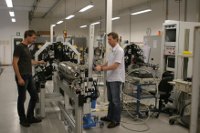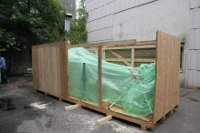 |
 |
|||||||||||||
|
|||||||||||||
|
|||||||||||||
|
When groups from different countries work together the usual procedure is to send the people to the machines they are working on. A team of engineers and technicians from DESY, Fermilab and KEK decided to do the exact opposite: they sent the machines to the people. On 3 August two machines constructed at DESY embarked on a voyage to Fermilab in the US.
The machines, so-called cavity tuning machines, which are used to form cavities for accelerator driven by superconducting radiofrequency technology like the European XFEL and the ILC, so that they match the construction plan exactly. Before the tuning starts the machines measure the shape of the cavities geometrically as well as electrically. Then they squeeze and stretch each cell of the cavity while keeping the cavity straight so that the electromagnetic field is exactly the same in every cell: this is the only way to guarantee an optimal acceleration of the particles inside the accelerator.
Experts at DESY have been working with a prototype of these machines for 15 years. Since a huge amount of cavities is needed for the ILC – 16000 of At Fermilab the cavity tuning machines will be used to support ILC R&D and Project X cavity tuning needs. One of them will later be shipped to KEK. But at the moment the machines are missing two important parts: the control electronics and the software. This is the American contribution to the cavity tuning machines and will be added at Fermilab. Before the machines could be shipped they had to be split in two parts, which were packed into boxes especially made for the machines' voyage. All movable parts were fastened and the machines were carefully tied up within the boxes. “Of course we are afraid that something might break, but we did our best to prevent this,” said Wolf-Dietrich Moeller, leader of the group at DESY which is part of the collaboration. His team and people from the packaging company needed about one week to pack the machines. Only after this was done accurately the machines were flown to the USA. In the middle of August a team from DESY followed the machines and helped to reassemble them. Finally it's again people who are sent to the machines... -- Gerrit Hörentrup, DESY |
|||||||||||||
| © International Linear Collider |

